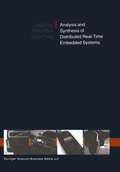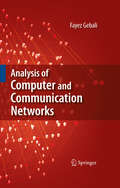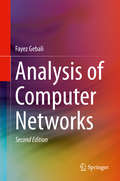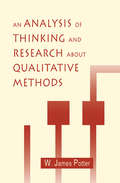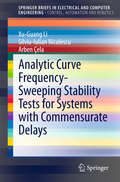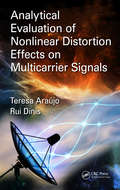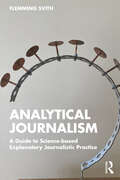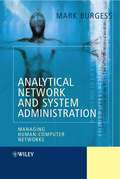- Table View
- List View
Analysis and Design of Stream Ciphers (Communications and Control Engineering)
by Rainer A. RueppelIt is now a decade since the appearance of W. Diffie and M. E. Hellmann's startling paper, "New Directions in Cryptography". This paper not only established the new field of public-key cryptography but also awakened scientific interest in secret-key cryptography, a field that had been the almost exclusive domain of secret agencies and mathematical hobbyist. A number of ex cellent books on the science of cryptography have appeared since 1976. In the main, these books thoroughly treat both public-key systems and block ciphers (i. e. secret-key ciphers with no memo ry in the enciphering transformation) but give short shrift to stream ciphers (i. e. , secret-key ciphers wi th memory in the enciphering transformation). Yet, stream ciphers, such as those . implemented by rotor machines, have played a dominant role in past cryptographic practice, and, as far as I can determine, re main still the workhorses of commercial, military and diplomatic secrecy systems. My own research interest in stream ciphers found a natural re sonance in one of my doctoral students at the Swiss Federal Institute of Technology in Zurich, Rainer A. Rueppe1. As Rainer was completing his dissertation in late 1984, the question arose as to where he should publish the many new results on stream ciphers that had sprung from his research.
Analysis and Synthesis of Distributed Real-Time Embedded Systems
by Paul Pop Petru Eles Zebo PengEmbedded computer systems are now everywhere: from alarm clocks to PDAs, from mobile phones to cars, almost all the devices we use are controlled by embedded computers. An important class of embedded computer systems is that of hard real-time systems, which have to fulfill strict timing requirements. As real-time systems become more complex, they are often implemented using distributed heterogeneous architectures. Analysis and Synthesis of Distributed Real-Time Embedded Systems addresses the design of real-time applications implemented using distributed heterogeneous architectures. The systems are heterogeneous not only in terms of hardware components, but also in terms of communication protocols and scheduling policies. Regarding this last aspect, time-driven and event-driven systems, as well as a combination of the two, are considered. Such systems are used in many application areas like automotive electronics, real-time multimedia, avionics, medical equipment, and factory systems. The proposed analysis and synthesis techniques derive optimized implementations that fulfill the imposed design constraints. An important part of the implementation process is the synthesis of the communication infrastructure, which has a significant impact on the overall system performance and cost. Analysis and Synthesis of Distributed Real-Time Embedded Systems considers the mapping and scheduling tasks within an incremental design process. To reduce the time-to-market of products, the design of real-time systems seldom starts from scratch. Typically, designers start from an already existing system, running certain applications, and the design problem is to implement new functionality on top of this system. Supporting such an incremental design process provides a high degree of flexibility, and can result in important reductions of design costs. Analysis and Synthesis of Distributed Real-Time Embedded Systems will be of interest to advanced undergraduates, graduate students, researchers and designers involved in the field of embedded systems.
Analysis and Transceiver Design for the MIMO Broadcast Channel (Foundations in Signal Processing, Communications and Networking #8)
by Raphael HungerThis book deals with the optimization-based joint design of the transmit and receive filters in MIMO broadcast channel in which the user terminals may be equipped with several antenna elements. Furthermore, the maximum performance of the system in the high power regime as well as the set of all feasible quality-of-service requirements is analyzed.First, a fundamental duality is derived that holds between the MIMO broadcast channel and virtual MIMO multiple access channel. This duality construct allows for the efficient solution of problems originally posed in the broadcast channel in the dual domain where a possibly hidden convexity can often be revealed. On the basis of the established duality result, the gradient-projection algorithm is introduced as a tool to solve constrained optimization problems to global optimality under certain conditions. The gradient-projection tool is then applied to solving the weighted sum rate maximization problem which is a central optimization that arises in any network utility maximization. In the high power regime, a simple characterization of the obtained performance becomes possible due to the fact that the weighted sum rate utility converges to an affine asymptote in the logarithmic power domain. We find closed form expressions for these asymptotes which allows for a quantification of the asymptotic rate loss that linear transceivers have to face with respect to dirty paper coding.In the last part, we answer the fundamental question of feasibility in quality-of-service based optimizations with inelastic traffic that features strict delay constraints. Under the assumption of linear transceivers, not every set of quality-of-service requirements might be feasible making the power minimization problem with given lower bound constraints on the rate for example infeasible in these cases. We derive a complete description of the quality-of-service feasibility region for arbitrary channel matrices.
Analysis of Computer and Communication Networks
by Fayez GebaliAnalysis of Computer and Communication Networks provides the basic techniques for modeling and analyzing two of the fundamental components of high performance networks: switching equipment, and software employed at the end nodes and intermediate switches. The book also reviews the design options used to build efficient switching equipment. Topics covered include Markov chains and queuing analysis, traffic modeling, interconnection networks, and switch architectures and buffering strategies. This book covers the mathematical theory and techniques necessary for analyzing telecommunication systems. Queuing and Markov chain analyses are provided for many protocols currently in use. The book then discusses in detail applications of Markov chains and queuing analysis to model more than 15 communications protocols and hardware components.
Analysis of Computer Networks
by Fayez GebaliThis textbook presents the mathematical theory and techniques necessary for analyzing and modeling high-performance global networks, such as the Internet. The three main building blocks of high-performance networks are links, switching equipment connecting the links together and software employed at the end nodes and intermediate switches. This book provides the basic techniques for modeling and analyzing these last two components. Topics covered include, but are not limited to: Markov chains and queuing analysis, traffic modeling, interconnection networks and switch architectures and buffering strategies.
The Analysis of Legal Cases: A Narrative Approach (Law, Language and Communication)
by Flora Di DonatoThis book examines the roles played by narrative and culture in the construction of legal cases and their resolution. It is articulated in two parts. Part I recalls epistemological turns in legal thinking as it moves from theory to practice in order to show how facts are constructed within the legal process. By combining interdisciplinary paradigms and methods, the work analyses the evolution of facts from their expression by the client to their translation within the lawyer-client relationship and the subsequent decision of the judge, focusing on the dynamic activity of narrative construction among the key actors: client, lawyer and judge. Part II expands the scientific framework toward a law-and-culture-oriented perspective, illustrating how legal stories come about in the fabric of the authentic dimensions of everyday life. The book stresses the capacity of laypeople, who in this activity are equated with clients, to shape the law, dealing not just with formal rules, but also with implicit or customary rules, in given contexts. By including the illustration of cases concerning vulnerable clients, it lays the foundations for developing a socio-clinical research programme, whose aims including enabling lay and expert actors to meet for the purposes of improving forms of collective narrations and generating more just legal systems.
The Analysis of Legal Cases: A Narrative Approach (Law, Language and Communication)
by Flora Di DonatoThis book examines the roles played by narrative and culture in the construction of legal cases and their resolution. It is articulated in two parts. Part I recalls epistemological turns in legal thinking as it moves from theory to practice in order to show how facts are constructed within the legal process. By combining interdisciplinary paradigms and methods, the work analyses the evolution of facts from their expression by the client to their translation within the lawyer-client relationship and the subsequent decision of the judge, focusing on the dynamic activity of narrative construction among the key actors: client, lawyer and judge. Part II expands the scientific framework toward a law-and-culture-oriented perspective, illustrating how legal stories come about in the fabric of the authentic dimensions of everyday life. The book stresses the capacity of laypeople, who in this activity are equated with clients, to shape the law, dealing not just with formal rules, but also with implicit or customary rules, in given contexts. By including the illustration of cases concerning vulnerable clients, it lays the foundations for developing a socio-clinical research programme, whose aims including enabling lay and expert actors to meet for the purposes of improving forms of collective narrations and generating more just legal systems.
Analysis of Periodically Time-Varying Systems (Communications and Control Engineering)
by John A. RichardsMany of the practical techniques developed for treating systems described by periodic differential equations have arisen in different fields of application; con sequently some procedures have not always been known to workers in areas that might benefit substantially from them. Furthermore, recent analytical methods are computationally based so that it now seems an opportune time for an applications-oriented book to be made available that, in a sense, bridges the fields in which equations with periodic coefficients arise and which draws together analytical methods that are implemented readily. This book seeks to ftll that role, from a user's and not a theoretician's view. The complexities of periodic systems often demand a computational approach. Matrix treatments therefore are emphasized here although algebraic methods have been included where they are useful in their own right or where they establish properties that can be exploited by the matrix approach. The matrix development given calls upon the nomenclature and treatment of H. D'Angelo, Linear Time Varying Systems: Analysis and Synthesis (Boston: Allyn and Bacon 1970) which deals with time-varying systems in general. It is recommended for its modernity and comprehensive approach to systems analysis by matrix methods. Since the present work is applications-oriented no attempt has been made to be complete theoretically by way of presenting all proofs, existence theorems and so on. These can be found in D'Angelo and classic and well-developed treatises such as McLachlan, N. W. : Theory and application of Mathieu functions.
Analysis of TCP Performance in Data Center Networks (SpringerBriefs in Electrical and Computer Engineering)
by Santosh Kulkarni Prathima AgrawalThis book addresses the need to improve TCP’s performance inside data centers by providing solutions that are both practical and backward compatible with standard TCP versions. The authors approach this challenge first by deriving an analytical model for TCP’s performance under typical data center workload traffic. They then discuss some solutions that are designed to improve TCP performance by either proactively detecting network congestion through probabilistic retransmission or by avoiding timeout penalty through dynamic resizing of TCP segments. Experimental results show that each of techniques discussed outperforms standard TCP inside a data center.
An Analysis of Thinking and Research About Qualitative Methods (Routledge Communication Series)
by W. James PotterWritten for social science scholars who want to learn more about the qualitative way of thinking, this book addresses the full continuum of issues about the qualitative methodologies. At one end of that continuum are the deeply philosophical concerns of ontology and epistemology. At the other -- concrete -- end of that continuum are the practical issues of what is considered evidence: How does one go about gathering evidence? Where, when, and how does one analyze evidence? What are the alternative ways of dealing with tone and voice in writing qualitative research? The attention to practical, concrete issues makes this book useful as a handbook providing a great deal of vital information to scholars who want a guide to making decisions as they navigate their research questions through the qualitative realm. Uniquely qualified to write such a book, Potter has earned PhDs in both qualitative methods (with a concentration in linguistics and field studies) and in quantitative methods (with a concentration in social science theory and statistics). The book is not an ideological argument that glorifies one system of thinking while attempting to persuade the reader that other systems of thinking are bankrupt. Rather, the book presents a respectful, balanced analysis of the strengths and weaknesses of the qualitative approach. The book builds to a controversial final chapter entitled "Is Convergence a Possibility?" in which Potter synthesizes a conclusion from his analysis of a wide range of qualitative studies across three broad topic areas -- text focused research, audience focused research, and institution focused research -- and across seven major qualitative methodologies -- ethnography, ethnomethodology, reception study, ecological psychology, symbolic interactionism, cultural studies, and textual analysis. His conclusion is that not only is there a possibility of a convergence between qualitative and quantitative approaches, but that the convergence has already happened. The book includes an appendix in which 95 books and articles using the qualitative approach are abstracted and analyzed to illustrate key points of methodology and methods. It also includes subject and author indexes.
An Analysis of Thinking and Research About Qualitative Methods (Routledge Communication Series)
by W. James PotterWritten for social science scholars who want to learn more about the qualitative way of thinking, this book addresses the full continuum of issues about the qualitative methodologies. At one end of that continuum are the deeply philosophical concerns of ontology and epistemology. At the other -- concrete -- end of that continuum are the practical issues of what is considered evidence: How does one go about gathering evidence? Where, when, and how does one analyze evidence? What are the alternative ways of dealing with tone and voice in writing qualitative research? The attention to practical, concrete issues makes this book useful as a handbook providing a great deal of vital information to scholars who want a guide to making decisions as they navigate their research questions through the qualitative realm. Uniquely qualified to write such a book, Potter has earned PhDs in both qualitative methods (with a concentration in linguistics and field studies) and in quantitative methods (with a concentration in social science theory and statistics). The book is not an ideological argument that glorifies one system of thinking while attempting to persuade the reader that other systems of thinking are bankrupt. Rather, the book presents a respectful, balanced analysis of the strengths and weaknesses of the qualitative approach. The book builds to a controversial final chapter entitled "Is Convergence a Possibility?" in which Potter synthesizes a conclusion from his analysis of a wide range of qualitative studies across three broad topic areas -- text focused research, audience focused research, and institution focused research -- and across seven major qualitative methodologies -- ethnography, ethnomethodology, reception study, ecological psychology, symbolic interactionism, cultural studies, and textual analysis. His conclusion is that not only is there a possibility of a convergence between qualitative and quantitative approaches, but that the convergence has already happened. The book includes an appendix in which 95 books and articles using the qualitative approach are abstracted and analyzed to illustrate key points of methodology and methods. It also includes subject and author indexes.
Analysis, Retrieval and Delivery of Multimedia Content (Lecture Notes in Electrical Engineering #158)
by Nicola Adami, Andrea Cavallaro, Riccardo Leonardi and Pierangelo MiglioratiCovering some of the most cutting-edge research on the delivery and retrieval of interactive multimedia content, this volume of specially chosen contributions provides the most updated perspective on one of the hottest contemporary topics. The material represents extended versions of papers presented at the 11th International Workshop on Image Analysis for Multimedia Interactive Services, a vital international forum on this fast-moving field. Logically organized in discrete sections that approach the subject from its various angles, the content deals in turn with content analysis, motion and activity analysis, high-level descriptors and video retrieval, 3-D and multi-view, and multimedia delivery. The chapters cover the finest detail of emerging techniques such as the use of high-level audio information in improving scene segmentation and the use of subjective logic for forensic visual surveillance. On content delivery, the book examines both images and video, focusing on key subjects including an efficient pre-fetching strategy for JPEG 2000 image sequences. Further contributions look at new methodologies for simultaneous block reconstruction and provide a trellis-based algorithm for faster motion-vector decision making.
Analytic Activism: Digital Listening and the New Political Strategy (Oxford Studies in Digital Politics)
by David KarpfAmong the ways that digital media has transformed political activism, the most remarkable is not that new media allows disorganized masses to speak, but that it enables organized activist groups to listen. Beneath the waves of e-petitions, "likes," and hashtags lies a sea of data - a newly quantified form of supporter sentiment - and advocacy organizations can now utilize new tools to measure this data to make decisions and shape campaigns. In this book, David Karpf discusses the power and potential of this new "analytic activism," exploring the organizational and media logics that determine how digital inputs shape the choices that political campaigners make. He provides the first careful analysis of how organizations like Change.org and Upworthy.com influence the types of political narratives that dominate our Facebook newsfeeds and Twitter timelines, and how MoveOn.org and its "netroots" peers use analytics to listen more effectively to their members and supporters. As well, he identifies the boundaries that define the scope of this new style of organized citizen engagement. But also raising a note of caution, Karpf identifies the dangers and limitations in putting too much faith in these new forms of organized listening.
ANALYTIC ACTIVISM OSDP C: Digital Listening and the New Political Strategy (Oxford Studies in Digital Politics)
by David KarpfAmong the ways that digital media has transformed political activism, the most remarkable is not that new media allows disorganized masses to speak, but that it enables organized activist groups to listen. Beneath the waves of e-petitions, "likes," and hashtags lies a sea of data - a newly quantified form of supporter sentiment - and advocacy organizations can now utilize new tools to measure this data to make decisions and shape campaigns. In this book, David Karpf discusses the power and potential of this new "analytic activism," exploring the organizational and media logics that determine how digital inputs shape the choices that political campaigners make. He provides the first careful analysis of how organizations like Change.org and Upworthy.com influence the types of political narratives that dominate our Facebook newsfeeds and Twitter timelines, and how MoveOn.org and its "netroots" peers use analytics to listen more effectively to their members and supporters. As well, he identifies the boundaries that define the scope of this new style of organized citizen engagement. But also raising a note of caution, Karpf identifies the dangers and limitations in putting too much faith in these new forms of organized listening.
Analytic Curve Frequency-Sweeping Stability Tests for Systems with Commensurate Delays (SpringerBriefs in Electrical and Computer Engineering)
by Xu-Guang Li Silviu-Iulian Niculescu Arben CelaIn this brief the authors establish a new frequency-sweeping framework to solve the complete stability problem for time-delay systems with commensurate delays. The text describes an analytic curve perspective which allows a deeper understanding of spectral properties focusing on the asymptotic behavior of the characteristic roots located on the imaginary axis as well as on properties invariant with respect to the delay parameters. This asymptotic behavior is shown to be related by another novel concept, the dual Puiseux series which helps make frequency-sweeping curves useful in the study of general time-delay systems. The comparison of Puiseux and dual Puiseux series leads to three important results:an explicit function of the number of unstable roots simplifying analysis and design of time-delay systems so that to some degree they may be dealt with as finite-dimensional systems;categorization of all time-delay systems into three types according to their ultimate stability properties; anda simple frequency-sweeping criterion allowing asymptotic behavior analysis of critical imaginary roots for all positive critical delays by observation.Academic researchers and graduate students interested in time-delay systems and practitioners working in a variety of fields – engineering, economics and the life sciences involving transfer of materials, energy or information which are inherently non-instantaneous, will find the results presented here useful in tackling some of the complicated problems posed by delays.
An Analytical Approach to Optical Burst Switched Networks
by T. Venkatesh C. Siva MurthyThis book presents the state of the art results on modeling and analysis of OBS networks. It provides researchers with new directions for future research and helps them gain a better understanding of modeling OBS networks. This book classifies all the literature on modeling and analysis of OBS networks and serves as a thought provoking material for the researchers working on the analysis of high-speed networks. The scope of this book however is not limited to OBS networks alone but extends to high-speed communication networks with limited or no buffers.
Analytical Evaluation of Nonlinear Distortion Effects on Multicarrier Signals
by Theresa Araújo Rui DinisDue to their ability to support reliable high quality of service as well as spectral and power efficiency, multicarrier modulation systems have found increasing use in modern communications services. However, one of the main drawbacks of these systems is their vulnerability to nonlinear distortion effects. Analytical Evaluation of Nonlinear Distort
Analytical Journalism: A Guide to Science-based Explanatory Journalistic Practice
by Flemming SvithResponding to an increasingly complex and often contradictory barrage of news information, Analytical Journalism offers a first-of-its-kind guide to this emerging form of science-based journalism. Posited as a practical alternative to other more traditional forms of event-driven news reporting, analytical journalism relies on metatheory and methodology to highlight causal factors such as goals, norms, behaviours and social frameworks when covering events. Seen as adjacent to investigative and data journalism, analytical journalism seeks to provide a solution to the simplification and under-reporting of the causal context by drawing on scientific research and data to offer a deeper understanding of news events. Central to this new field is public understanding; providing news consumers with the information they require to navigate and act with nuance in the real world. Drawing on the author’s experience of teaching analytical journalism at the postgraduate level, this book summarises the aims and theory of the field and contains practical tools to help improve journalists’ contribution to shared public knowledge, including methods and examples of identifying and justifying new causal explanations of an issue. Analytical Journalism will be of interest to advanced journalism students and practitioners exploring alternative forms of journalism.
Analytical Journalism: A Guide to Science-based Explanatory Journalistic Practice
by Flemming SvithResponding to an increasingly complex and often contradictory barrage of news information, Analytical Journalism offers a first-of-its-kind guide to this emerging form of science-based journalism. Posited as a practical alternative to other more traditional forms of event-driven news reporting, analytical journalism relies on metatheory and methodology to highlight causal factors such as goals, norms, behaviours and social frameworks when covering events. Seen as adjacent to investigative and data journalism, analytical journalism seeks to provide a solution to the simplification and under-reporting of the causal context by drawing on scientific research and data to offer a deeper understanding of news events. Central to this new field is public understanding; providing news consumers with the information they require to navigate and act with nuance in the real world. Drawing on the author’s experience of teaching analytical journalism at the postgraduate level, this book summarises the aims and theory of the field and contains practical tools to help improve journalists’ contribution to shared public knowledge, including methods and examples of identifying and justifying new causal explanations of an issue. Analytical Journalism will be of interest to advanced journalism students and practitioners exploring alternative forms of journalism.
Analytical Methodology of Tree Microstrip Interconnects Modelling For Signal Distribution: Voltage Transfer Function and S-parameter Analyses
by Blaise RaveloThis book focuses on the modelling methodology of microstrip interconnects, discussing various structures of single-input multiple-output (SIMO) tree interconnects for signal integrity (SI) engineering. Further, it describes lumped and distributed transmission line elements based on single-input single-output (SIMO) models of symmetric and asymmetric trees, and investigates more complicated phenomenon, such as interbranch coupling. The modelling approaches are based on the analytical methods using the Z-, Y- and T-matrices. The established method enables the S-parameters and voltage transfer function of SIMO tree to be determined. Providing illustrative results with frequency and time domain analyses for each tree interconnect structure, the book is a valuable resource for researchers, engineers, and graduate students in fields of analogue, RF/microwave, digital and mixed circuit design, SI and manufacturing engineering.
Analytical Methods for Network Congestion Control (Synthesis Lectures on Learning, Networks, and Algorithms)
by Steven LowThe congestion control mechanism has been responsible for maintaining stability as the Internet scaled up by many orders of magnitude in size, speed, traffic volume, coverage, and complexity over the last three decades. In this book, we develop a coherent theory of congestion control from the ground up to help understand and design these algorithms. We model network traffic as fluids that flow from sources to destinations and model congestion control algorithms as feedback dynamical systems. We show that the model is well defined. We characterize its equilibrium points and prove their stability. We will use several real protocols for illustration but the emphasis will be on various mathematical techniques for algorithm analysis. Specifically we are interested in four questions: 1. How are congestion control algorithms modelled? 2. Are the models well defined? 3. How are the equilibrium points of a congestion control model characterized? 4. How are the stability of these equilibrium points analyzed? For each topic, we first present analytical tools, from convex optimization, to control and dynamical systems, Lyapunov and Nyquist stability theorems, and to projection and contraction theorems. We then apply these basic tools to congestion control algorithms and rigorously prove their equilibrium and stability properties. A notable feature of this book is the careful treatment of projected dynamics that introduces discontinuity in our differential equations. Even though our development is carried out in the context of congestion control, the set of system theoretic tools employed and the process of understanding a physical system, building mathematical models, and analyzing these models for insights have a much wider applicability than to congestion control.
Analytical Network and System Administration: Managing Human-Computer Networks
by Mark BurgessNetwork and system administration usually refers to the skill of keeping computers and networks running properly. But in truth, the skill needed is that of managing complexity. This book describes the science behind these complex systems, independent of the actual operating systems they work on. It provides a theoretical approach to systems administration that: saves time in performing common system administration tasks. allows safe utilization of untrained and trained help in maintaining mission-critical systems. allows efficient and safe centralized network administration. Managing Human-Computer Networks: Will show how to make informed analyses and decisions about systems, how to diagnose faults and weaknesses Gives advice/guidance as to how to determine optimal policies for system management Includes exercises that illustrate the key points of the book The book provides a unique approach to an old problem and will become a classic for researchers and graduate students in Networking and Computer Science, as well as practicing system managers and system administrators.
Analytical Network and System Administration: Managing Human-Computer Networks
by Mark BurgessNetwork and system administration usually refers to the skill of keeping computers and networks running properly. But in truth, the skill needed is that of managing complexity. This book describes the science behind these complex systems, independent of the actual operating systems they work on. It provides a theoretical approach to systems administration that: saves time in performing common system administration tasks. allows safe utilization of untrained and trained help in maintaining mission-critical systems. allows efficient and safe centralized network administration. Managing Human-Computer Networks: Will show how to make informed analyses and decisions about systems, how to diagnose faults and weaknesses Gives advice/guidance as to how to determine optimal policies for system management Includes exercises that illustrate the key points of the book The book provides a unique approach to an old problem and will become a classic for researchers and graduate students in Networking and Computer Science, as well as practicing system managers and system administrators.
Analyzing Digital Discourse: New Insights and Future Directions
by Pilar Garcés-Conejos Blitvich Patricia Bou-FranchThis innovative edited collection presents new insights into emerging debates around digital communication practices. It brings together research by leading international experts to examine methods and approaches, multimodality, face and identity, across five thematically organised sections. Its contributors revise current paradigms in view of past, present, and future research and analyse how users deploy the wealth of multimodal resources afforded by digital technologies to undertake tasks and to enact identity. In its concluding section it identifies the ideologies that underpin the construction of digital texts in the social world. This important contribution to digital discourse studies will have interdisciplinary appeal across the fields of linguistics, socio-linguistics, pragmatics, discourse analysis, gender studies, multimodality, media and communication studies.
Analyzing Digital Discourses: Between Convergence and Controversy
by Marjut Johansson Sanna-Kaisa Tanskanen Jan ChovanecThis book contributes to the scholarly debate on the forms and patterns of interaction and discourse in modern digital communication by probing some of the social functions that online communication has for its users. An array of experts and scholars in the field address a range of forms of social interaction and discourses expressed by users on social networks and in public media. Social functions are reflected through linguistic and discursive practices that are either those of ‘convergence’ or ‘controversy’ in terms of how the discourse participants handle interpersonal relations or how they construct meanings in discourses. In this sense, the book elaborates on some very central concerns in the area of digital discourse analysis that have been reported within the last decade from various methodological perspectives ranging from sociolinguistics and pragmatics to corpus linguistics. This edited collection will be of particular interest to scholars and students in the fields of digital discourse analysis, pragmatics, sociolinguistics, social media and communication, and media and cultural studies.

